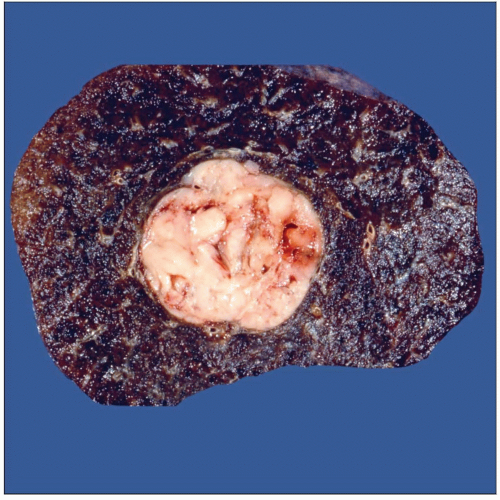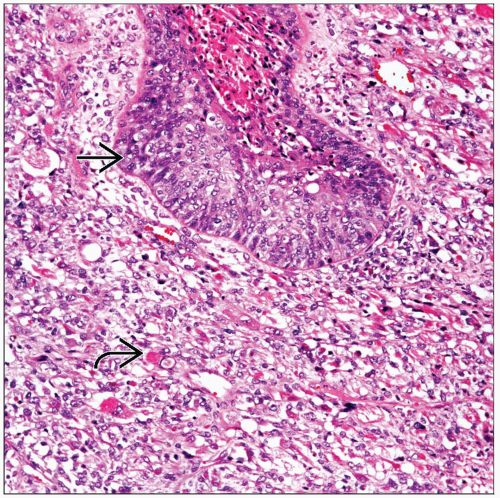Carcinosarcoma
Key Facts
Terminology
Malignant biphasic neoplasm composed of malignant epithelial and malignant mesenchymal components
Etiology/Pathogenesis
Carcinosarcomas have been linked to tobacco use
Clinical Issues
More common in men than women
May be central or peripheral
Macroscopic Features
Central tumors may grow in polypoid fashion, obstructing airways
Peripheral tumors may reach large size
Areas of necrosis &/or hemorrhage are common
2 cm to > 10 cm in diameter
Microscopic Pathology
Biphasic
Presence of conventional carcinoma (any type) with sarcoma (any type)
Squamous cell carcinoma is most common epithelial component
Epithelial, biphasic, or mixed
Top Differential Diagnoses
Carcinoma
In small biopsy specimen where only epithelial component is present
Sarcoma
In small biopsy specimen where only sarcomatous component is present
 Gross photograph of pulmonary carcinosarcoma shows a well-circumscribed, light tan, fleshy intrapulmonary mass. Note the absence of necrosis and hemorrhage. |
TERMINOLOGY
Abbreviations
Carcinosarcoma (CSC)
Definitions
Malignant biphasic neoplasm composed of malignant epithelial and malignant mesenchymal components
ETIOLOGY/PATHOGENESIS
Environmental Exposure
Carcinosarcomas have been linked to tobacco smoke
Etiology
Collision tumor
Composite tumor
Tumor derived from stem cells with multiple differentiation
Biphasic sarcomatoid carcinomas
CLINICAL ISSUES
Epidemiology
Incidence
More common in men than women
Site
May be central or peripheral
Presentation
Cough
Dyspnea
Hemoptysis
Chest pain
Weight loss
Obstructive pneumonia
Treatment
Surgical approaches
Complete resection
Adjuvant therapy
No definitive specific treatment
Prognosis
Poor
MACROSCOPIC FEATURES
General Features
Central tumors may grow in polypoid fashion, obstructing airway
Peripheral tumors may reach large size
Areas of necrosis &/or hemorrhage are common
Size
2 cm to > 10 cm in diameter
MICROSCOPIC PATHOLOGY
Histologic Features
Presence of conventional carcinoma (any type) with sarcoma (any type)
Squamous cell carcinoma is most common epithelial component
Predominant Pattern/Injury Type
Biphasic
Predominant Cell/Compartment Type
Epithelial, biphasic, or mixed
DIFFERENTIAL DIAGNOSIS
Carcinoma
Sarcoma
In small biopsies if only component is mesenchymal
In larger specimens, presence of any heterologous sarcomatous component in association with carcinoma is diagnostic
Stay updated, free articles. Join our Telegram channel

Full access? Get Clinical Tree





